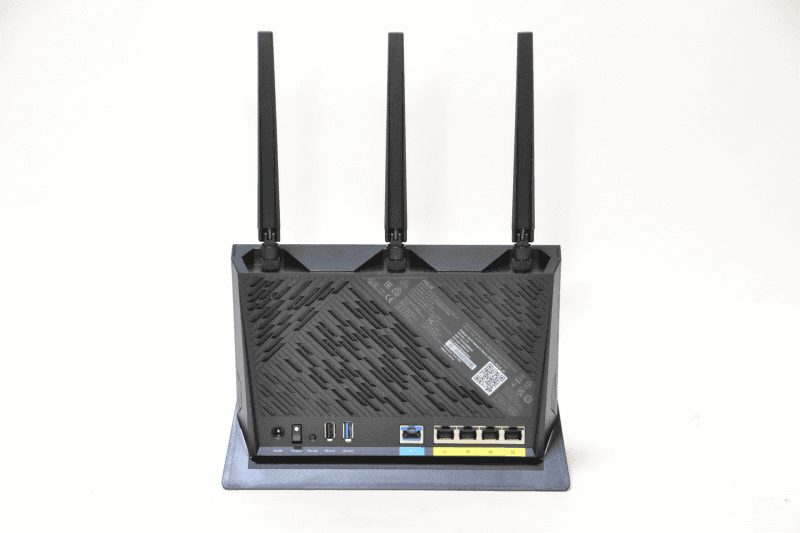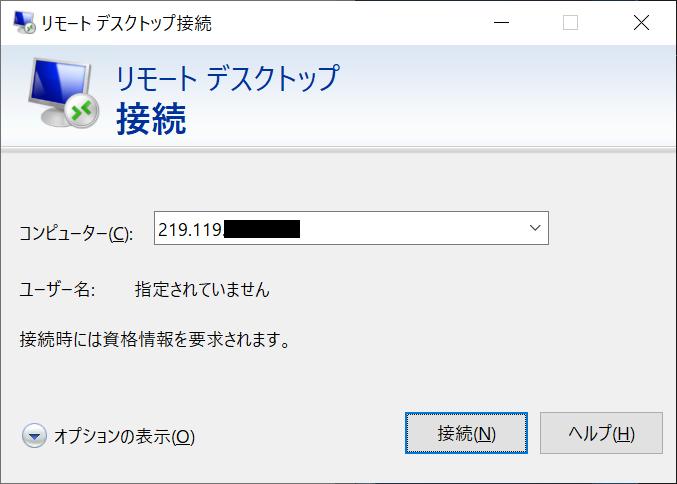ASUS announced a new product "RT-AX86S" of Wi-Fi 6 compatible router.
This product is equipped with Wi-Fi 6 up to 4804Mbps and LAN of 1000BASE-T. It is a product in the class that can be said to be "mid-level" in terms of specifications.
Above that, there are high-speed models such as tri-band compatible and 2.5GBASE-T compatible, but it is not necessary to have such "upper" specifications, but it can be said that it is a product that meets the needs such as wanting a solid product. ..
Then, I would like to think about what kind of points the "RT-AX86S" has and what kind of people can recommend it.
First of all, I think the points are "basically high performance" and "multifunctional USB port". In particular, the latter has quite interesting functions such as being able to create your own cloud storage and automatically switching to a spare line.
Supports Wi-Fi 6 up to 4804 Mbps, is 2.5GBASE-T not installed the point of choice?
First, check the specifications of "RT-AX86S".
The speed of Wi-Fi 6 is 4804 Mbps, which is the maximum in the 5 GHz band at present. The 2.4GHz band is 861Mbps.
Other spec points are that it is equipped with a 1000BASE-T LAN (5 ports in total for WAN / LAN) and that it has two USB ports, one of which is compatible with USB 3.2 Gen1. The CPU is dual core (1.8GHz) and the memory capacity is 512MB.
It also supports the company's unique mesh function "AiMesh", and can also use unique functions such as AiProtection and Game Boost.
RT-AX86S specs
| Actual selling price (tax included) | Around 27,000 yen |
| CPU | Dual core, 1.8GHz |
| memory | 512MB |
| Wi-Fi standard | Wi-Fi 6 |
| Maximum speed (2.4GHz band) | 861Mbps |
| Maximum speed (5GHz band) | 4804Mbps |
| Number of streams | 4x4 (3x3 for 2.4GHz band) |
| WAN | 1000BASE-T x 1 |
| LAN | 1000BASE-T x 4 |
| USB | USB 3.2 Gen1 x 1, USB 2.0 x 1 |
Other products of the company that support 4804 Mbps with Wi-Fi 6 include "RT-AX82U" and "TUF-AX5400". Compared to these, the number of USB terminals and the number of streams in the 2.4GHz band are superior, and the main unit can be placed vertically.
The appearance that you want to be unified in black makes it attractive to install vertically
The appearance is unified in black as a whole, and there is a red one point at the bottom of the front. The design is a futuristic exterior like a 3D polygon often found on the company's routers. However, the unevenness is not so big, and the color is unified, so the self-assertion is modest.
Thanks to the vertical installation type, it does not take up an installation area, so it will be convenient when used in combination with the vertical installation type ONU. The height of the antenna can be lowered to some extent by changing the angle, but when it is upright, the height becomes about 32 cm.
Stable communication without breaking the link even at long distances
Next, use iperf3 to test the communication speed of the Wi-Fi connection. The handset is a notebook PC that supports a bandwidth of 160MHz, and the maximum link speed is 2402Mbps. The communication partner is a PC connected by wire with 1000BASE-T.
In addition to short-range communication in the same room, in the 3LDK condominium, which is the author's house, this unit was placed in the room on the aisle side and the PC was placed at the end of the room on the veranda side for communication. There are three wooden doors in between, and with the NURO Hikari home gateway "HG8045Q" at the author's house, the 5GHz band link is cut off.
The descent is very stable at short distances, and the result is satisfactory in terms of speed. Although there is some variation in speed on the upstream, it is at least 765 Mbps in 10 trials, so it should not be a concern in practice.
At long distances, both uplink and downlink are around 30 Mbps. Looking at the data, the values were stable in all cases, and there were no interruptions in communication or links. It's not as fast as the data from other products, but the connection stability is quite high. Not only is there no stress for general purposes such as web browsing, but there is also a sense of security that stable communication can be obtained even in games.

You can realize cloud storage and "spare line"!High-performance USB port
Another feature of this unit is that it has two USB ports. There are quite a few Wi-Fi routers that have a USB port, but many people haven't used it before. I would like to try out what can be done with the USB port of this unit.
Regarding the USB function, there are few setting items in the "ASUS Router" application for smartphones, so it is better to log in to this unit from a web browser and set it. On the web browser settings screen, the related functions are summarized in a tab called "USB application".
The specific functions provided are as follows. Let's explain in order.
AiDisk (Internet storage function)
Server center (various network storage functions)
Network printer server
3G / 4G (USB modem function)
Time Machine (for MacOS)
Download master (file downloader without PC)
AiDisk (Internet storage function)
"AiDisk" is a function to publish the connected USB storage to the Internet. The setting will proceed in a wizard format, and it will be published as an FTP server, and the domain by DDNS provided by the company will also be provided. So to speak, it is a function that allows you to create "self-made cloud storage".
Furthermore, it also links to the company's original Internet storage function "AiCloud 2.0". "Cloud Disk" that allows you to access USB storage from a smartphone app or web browser, "Smart Access" that allows you to access a PC on a LAN via the Internet, "AiCloud" that synchronizes data on USB storage with the company's cloud storage service "ASUS Webstorage" "Sync" is available. These can be used by selecting the required functions.
Unfortunately, I couldn't test the functions of "AiDisk" including "AiCloud 2.0" because there is no way to assign a global IP address to this unit on the NURO optical line at my house. However, it was confirmed that the setting work is not so difficult and it can be easily started in a few steps.
Server center (various network storage functions)
"Server Center" utilizes USB storage as network storage in a LAN, and has several functions. First of all, "Media Server" has iTunes server function and UPnP server function. It can be used as a multimedia server in combination with UPnP compatible devices.
In the next "Samba Sharing / Cloud Disk", you can set the file sharing function. If you set the device name and workgroup, you can use it in the same way as Windows file sharing, and it functions as a simple NAS. There is also a function to set read and write permissions for each folder.
Regarding the last "FTP sharing", the same FTP server function that was set in "AiDisk". You can do everything you want with the FTP server, such as access from the WAN side and anonymous access, TLS support, maximum number of simultaneous connections, character code, and read / write permissions for each folder.
Network printer server
A "network printer server" literally operates a printer connected to a USB port as a network printer.
Even a printer that has no network function and has only a USB connection method can be used as a network printer by connecting it to the USB port of this unit.
3G / 4G (USB modem function)
"3G / 4G (USB modem function)" connects a USB modem or Android smartphone and uses it as an internet line.
If you connect this unit to a smartphone via USB, select "Android smartphone" in the "Select device" item on the setting screen, and enable USB tethering on the smartphone side, you can communicate with this unit via the smartphone.
And what's interesting is that this unit has a dual WAN function. This means that you can switch to the secondary line after the WAN communication is cut off for a certain period of time, and you can use the mobile line as a backup backup line without changing the Wi-Fi settings of your PC.
I think there are many people who want to stabilize the Internet environment at home, but it can be said that it is a function that is of concern to such people.
Time Machine (for MacOS)
"Time Machine (for MacOS)" is a function used as backup storage for macOS. Time Machine can be realized with the Samba share introduced earlier, but here you can limit the capacity used for Time Machine.
Download Master
"Download Master" is a function that allows you to download files without going through a PC. If you specify the URL of the file from the setting screen, the file will be downloaded to the storage connected to the USB port. The URLs that can be used are HTTP and FTP, as well as P2P networks such as eMule and Torrent.
When downloading a large file that takes a long time to download, leaving the PC running may be a concern from the viewpoint of heat generation, noise, energy saving, etc. If you use this function, if you have a storage connected to this unit and a USB port, you can download even when the power of the PC is turned off.
Although there is a problem that you can not use a URL that requires some kind of authentication before downloading, it is useful for downloading large files that take several hours or more.
Test the speed difference between USB 3.0 and storage connected to USB 2.0
That's all for the functional description of the USB port, but here's one more test. This unit has two USB ports, one of which is different from USB 3.0 and the other of which is USB 2.0. So I connected a USB storage to each USB port and examined the difference in actual speed.
The one used for the test was a SATA cradle with a USB 3.0 connection and a 64GB SSD attached. Guest access was enabled (no password) for disk sharing by Samba of this unit, and the one connected to the USB 3.0 port and the USB 2.0 port respectively and the one connected directly to the PC were measured using "CrystalDiskMark". Wi-Fi 6 (maximum 2402 Mbps) was connected between this unit and the PC.
Looking at the results, the sequential read was about 110MB / s when connected to the USB 3.0 port, and about 40MB / s when connected to the USB 2.0 port. Considering that it is about 270MB / s when directly inserted into a PC, I would like it to be a little faster when connected to a USB 3.0 port, but the speed is comparable to the limit value of 1000BASE-T of wired LAN. It is enough if it is actually measured. This is a satisfactory result for online storage.
As mentioned above, various functions can be used with the USB port of this unit. As an actual usage method, it is better to connect a high-speed storage such as HDD or SSD to the USB 3.0 port. You can use AiDisk to create cloud storage, or you can use an inexpensive external HDD as a NAS for your home.
It seems good to connect a printer to the USB 2.0 port and prepare a network printer. With recent telework, many people should have more opportunities to use printers at home. Even a printer that does not have a network function can be turned into a network printer by connecting it to this unit via USB, so that anyone in the family can use it whenever they want. Or you can use additional storage, assuming it can be slow.
By the way, when I tried it with removable media such as USB memory, it sometimes did not work well. In the case of my 64GB USB memory, the one formatted with exFAT did not work, and I could access it for some reason by HFS formatting with this unit (I could use it even if I reformatted it with NTFS after that). If it doesn't work even if you connect the USB storage, you may try formatting it from this unit.

![EVsmart blog Toyota's electric car "bZ4X" that makes you feel comfortable with electric cars and quick chargers / No% display of battery level [Editorial department] Popular articles Recent posts Category](https://website-google-hk.oss-cn-hongkong.aliyuncs.com/drawing/article_results_9/2022/3/9/752542064665dc2bd7addbc87a655694_0.jpeg)
![Lenovo's 8.8 inch one-handed tab "Legion Y700" full specs released! [Is the price in the 40,000 yen range?]](https://website-google-hk.oss-cn-hongkong.aliyuncs.com/drawing/article_results_9/2022/3/9/207e1be231154e91f34c85b4b1d2126c_0.jpeg)

